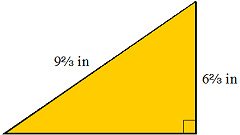Checking back with Example 1 will show a consistent result for the triangle's Area using the conventional
|
ordinary; commonplace; traditional or customary |
|---|
|
acclaimed; publicly and/or previously announced; foretold |
|---|
PYTHAGOREAN THEOREM *

| a² + b² = c² |
|---|
Find the length of the unknown side for the triangle shown in the illustration.

| ( | 623in | ) | ² | + | b | ² | = | ( | 923in | ) | ² | ||
| 4449in² | + | b | ² | = | 9349in² | ||||||||
| b | ² | = | 9349in² | - | 4449in² | ||||||||
| b | ² | = | 49 in² | ||||||||||
| b | = | √49 in² | |||||||||||
| b | = | 7 in | |||||||||||
Once one grasps what has happened here, you
* The importance of this mathematical formula is difficult to overemphasize as it will be a necessity for a significant number
of problems throughout the remainder of the course/text.